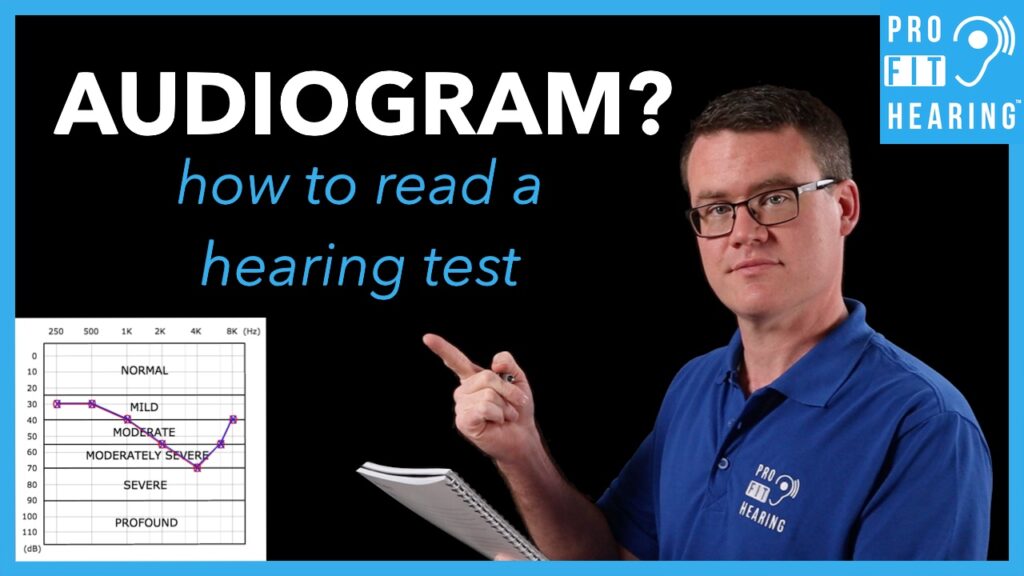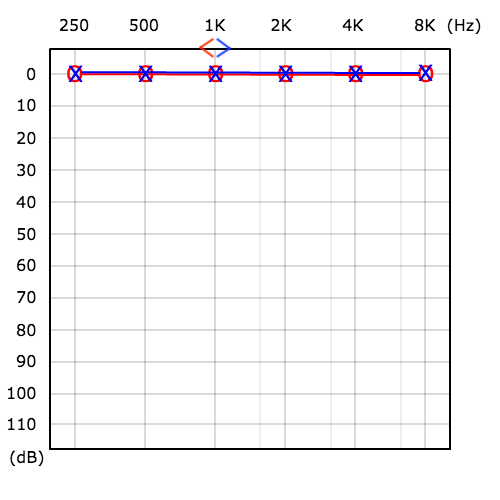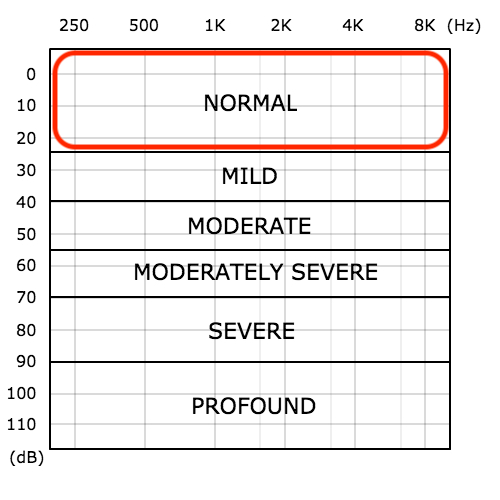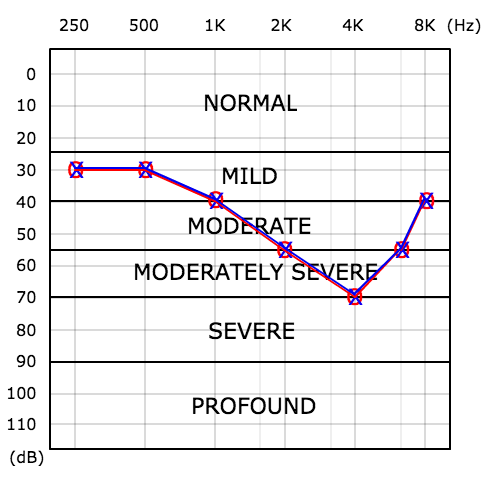Audiogram?-How To Read a Hearing Test

Do you have an audiogram but don’t know how to read it? Well, in this post I’m talking about how to read a hearing test. Coming up!
Please SUBSCRIBE to our YouTube channel for weekly videos! The video link is at the end of this post.
Hi, I’m Dr. Derek, audiologist with Pro Fit Hearing.com bringing you the best insight into today’s latest hearing aids and audio technology to improve your life. If you have concerns about your hearing, always consult with your local physician or audiologist.
Today, I’m talking about how to read your audiogram. Understanding your audiogram is the first step to knowing if you have hearing loss, how hearing loss may impact you, and what kind of treatment you might benefit from.
The Audiogram
When you have a hearing test, the results are recorded on a graph called the audiogram. A hearing test is completed while wearing headphones and shows how well you hear sounds ranging from low to high pitches. The sounds start off soft and are gradually increased to determine the level where you can just barely hear the sound. This is your threshold level that is recorded on the audiogram.
In addition to using regular headphones for testing, there is also a headphone that rests behind your ear on the bone. It’s called a bone conductor, and it measures how well you hear sounds through the skull.
You will also be asked to repeat back words to see how well you understand speech in quiet with no visual cues (no lip reading). Testing is completed in a sound treated booth so that an accurate result can be obtained.
The soft sounds (or beeps) you hear during the hearing test are called pure tones. Your responses are arranged on the audiogram according to the pitch (which is measured in frequency in Hertz or Hz, along the top) and volume (which is measured in decibels or dB, on the side).

Pitch is arranged from low (on the lefthand side) to high (on the righthand side) just like a piano. A volume of 0 dB at the top is very soft while 110 dB at the bottom is extremely loud like a jet engine. A red “O” indicates right ear results, and a blue “X” indicates left ear results.
The O and Xs are your responses to the hearing test and indicate the softest level you hear each tone. The O and Xs mark your hearing threshold levels for air conduction (or regular headphones). You should also have a small, blue or red bracket near to or above the O and Xs which indicate how well you heard the tones with bone conduction.

This audiogram indicates normal hearing thresholds in both ears at a very soft volume of 0 dB for all the low and high pitch sounds.

This audiogram shows all the different degrees of hearing loss that may exist. Your hearing is within normal range if all O and Xs are at 25 dB or less (for adults).

Any results outside the normal range is considered hearing loss that can potentially have an impact on daily communication. The severity and configuration of the hearing loss is important when deciding whether to proceed with hearing aids.
Hearing aids can improve speech understanding and communication anytime your results fall outside of the normal range, but make sure to consult with your audiologist (or Doctor of Audiology) to determine if a hearing aid is right for you.
Audiogram sample
I’m now going to explain a sample audiogram so that you can have a better understanding of how to read your own audiogram results.
This audiogram indicates a hearing loss in both ears. You can see that the position of the O and Xs are exactly the same meaning there was no difference in hearing between the right and left ears for all of the sounds from low to high pitches. This person experiences decreased hearing sensitivity mostly in the high pitches which is very common.

The audiogram shows that this person’s thresholds for the low pitch tones are in the 30-40 dB range while their thresholds for the high pitch tones are mostly in the 55-70 dB range. Hearing loss with this configuration is often caused by loud noise exposure and gradual hearing loss associated with aging.
All of the sounds below the blue & red lines are audible to this person, while all sounds above the blue & red lines are not audible.


Without hearing aids, this person will not hear a large percentage of sounds that an otherwise normal hearing listener would experience. Hearing aids adjusted to this audiogram would amplify the high pitch sounds more than the low pitch sounds so that this person could have improved speech understanding and clarity of words.
Audiogram results – impact on hearing
Hearing loss in the high pitch tones can significantly impact the ability to understand words, especially in background noise. High pitch sounds correspond to the consonants in speech, and these sounds provide the fine detail and understanding of words. Hearing loss in the high pitch range makes it difficult to understand what people are saying. The other person may be speaking loud enough but their words just aren’t clear.
Understanding speech is especially difficult for a hearing impaired person when seated a far distance from the speaker, in the presence of background noise, and when the speaker’s mouth can not be visualized while speaking. So if you have hearing loss and want to improve your ability to understand what is being said, make sure you minimize distance, reduce background noise, and face the person speaking for better visual cues.
Word Recognition
In addition to measuring the soft tones that we hear, word recognition ability is also recorded on the audiogram. Words are presented at a comfortable volume in quiet to determine whether you have any difficulty understanding words. If you have hearing loss, word recognition scores are also an estimate of how well you will understand words while wearing hearing aids in a quiet environment.
Hearing aids are designed to boost hearing so that words sound more clear and are easier to understand. If you have good word recognition scores, you should adapt well to hearing aids. People with more severe hearing loss may have poor word recognition even when listening to words at a loud volume. In these cases, a hearing aid may not make words clear enough to understand so a cochlear implant surgery may be considered by an Ear, Nose, and Throat doctor. Your audiologist and ENT doctor can conduct a cochlear implant evaluation to determine if you are a candidate.
Audiogram – screening tests
In addition to soft sound and word testing, a few other screening tests may appear on the audiogram. These can include tympanograms, acoustic reflexes, and otoacoustic emissions (or OAEs).
Tympanograms
A tympanogram applies some pressure inside the ear canal to see if there is normal eardrum movement. Abnormal eardrum movement may indicate an ear infection, middle ear fluid, or something abnormal with ear bone function. If your tympanogram shows a flat line across, that could be an indication of middle ear fluid or possibly an eardrum rupture which should be evaluated by your physician as soon as possible.
Acoustic Reflexes
Acoustic reflexes are a measure of how the eardrum moves in response to loud sounds. Normally, an acoustic reflex should be present in both ears. An absence of acoustic reflexes may be caused by various types of hearing loss or other medical issues.
Otoacoustic Emissions (OAEs)
Otoacoustic emissions (or OAEs) are recorded from the ear’s outer hair cells in response to soft tones. Hair cells are located inside the inner ear and are responsible for transmission of auditory signals up to the brain. This test does not require any response from the patient, and it results in a PASS or FAIL. A FAIL result is expected if the patient has hearing loss and/or abnormal middle ear function. This test is especially helpful to estimate a patient’s hearing sensitivity when they can not respond reliably to other behavioral testing.
Question of the Day
So for today’s question, do you feel more comfortable reading your own audiogram? Was this video helpful? I’d love to know your thoughts, so please comment below. What other videos do you want to see? Let’s connect in the comments.
Make sure to check out my other posts where I discuss the different types of hearing loss that may be identified on the audiogram. These include conductive, sensorineural, or mixed hearing loss. I’ll post that on the blog as soon as it’s available. Your audiologist can advise you on specific treatment options for your hearing loss.
Remember to connect with Pro Fit Hearing on social media. Be a part of the Pro Fit Hearing community!
If you are interested in hearing aids, click HERE for my FREE ebook, “How To Buy Hearing Aids”. Know what to ask your audiologist or hearing aid dispenser so that your hearing aids are easy to use and have all the features you’re looking for.
Remember, Pro Fit Hearing brings you the best insight into today’s latest hearing aids and audio technology to improve your life. If you have concerns about your hearing, always consult with your local physician or audiologist.
-Dr. Derek
